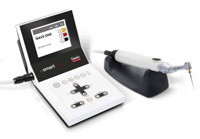 Electro/mechanical Single Visit, Root Canal Therapy
Electro/mechanical Single Visit, Root Canal Therapy
New technology, which allows the dentist to mechanically prepare the tooth root internally, to a smooth and clean surface, means that in most cases, a root canal therapy can be completed in just a single visit. The procedure is fast, painless and can save you multiple visits and the need to be numbed more than once. Forty years of research from around the world shows that an effective  and long term root canal therapy can be comfortably achieved using special techniques in combination with the Reciprocating Endodontic Handpiece using hyper-flexing, torsional, root-tapering instruments.
and long term root canal therapy can be comfortably achieved using special techniques in combination with the Reciprocating Endodontic Handpiece using hyper-flexing, torsional, root-tapering instruments.
If this therapy is suitable for you, the dentist uses the Reciprocating Endodontic Handpiece to electro/mechanically prepare the tooth root, from the inside of the tooth cavity chamber. Nickel-titanium instruments simultaneously clean the inside of the tooth, whilst the equipment constantly measures data that the dentist needs to know, in order to provide excellent, consistent results.
Mercury-Free Tooth-Coloured Fillings
Composite fillings are an aesthetic alternative to silver fillings. Composites are naturally white fillings that can be tinted to match any tooth colour. For the patient, the procedure is just as simple as, though requiring more skill from the doctor than, the procedure for silver fillings and can be inserted during a single office visit.
Restorations in composite resin can last many years and are a very conservative tooth restoration, if constructed well and then well maintained. In larger filling situations, there are some strength and wear characteristics that are not as ideal and the tooth may need a stronger restoration such as gold or a porcelain inlay.
Composite resins are useful for cosmetic bonding where unsightly gaps, chipped or worn teeth can be repaired or reshaped.
Tooth Fissure Sealants
Sealants are helping to create a generation of youngsters that are nearly cavity-free. Statistics show that one out of every three children between the ages of 5 and 17 has never had a cavity. Dental professionals attribute water fluoridation and use of sealants with helping to bring about this rapid decline in cavities.
The use of sealants does not eliminate the need for regular attention to dental care. Dentists, therapists and hygienists recommend regular brushing and flossing, attention to the amount of sugary foods consumed, and to the frequency with which they are eaten. The teeth are subjected to an acid attack every time sugary foods are eaten, causing an erosive action that can break down healthy enamel.
The plastic-like coating, called a pit and fissure sealant, is applied to the chewing surface of the back teeth and to indentations and nicks in the surfaces of teeth. Sealants are used by dental professionals as a preventive measure to ward off decay that tends to settle into hidden crevices in the teeth.
The preventive plastics are also used to seal “fissures”, or joint lines in a tooth’s enamel created while the tooth is being formed. A perfect fissure should be tightly sealed, but often several spots along the length of the fissure will open directly into the tooth. Food and bacteria collect there. This eventually weakens the tooth and causes decay. Sealants help during the formative stages so they can withstand the effect of sugar and stress later on.
To apply the sealant, the dentist, therapist or hygienist first cleans the tops and sides of selected teeth. The tooth enamel is then treated with an acid solution that etches the surface of the tooth, causing it to be temporarily porous and somewhat rough.
The liquid sealant, clear or milky white in colour, is applied and allowed to harden. Within a few days, the excess plastic wears off, leaving the sealant only in the pits and fissures. The plastic covering is only temporary, and must be checked periodically for flaws.



